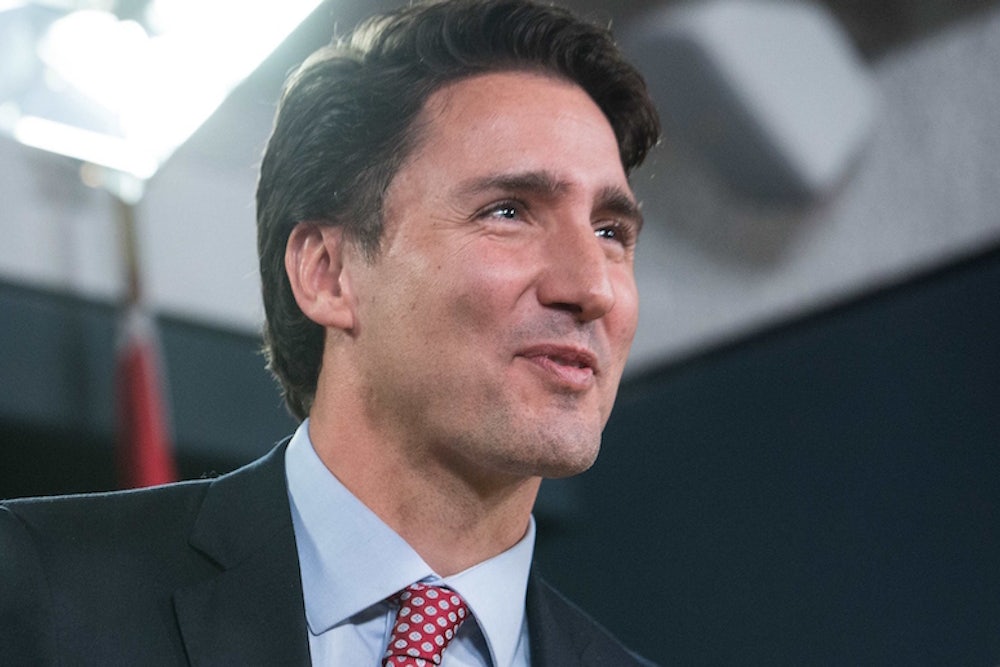There’s one thing that virtually everyone can agree about incoming Canadian Prime Minister Justin Trudeau: He’s sexy.
Immediately after his victory in October, the international press was filled with articles describing him as “super hot” and “hunky.” Yet it’s a mistake to see Trudeau’s sexiness as merely a personal attribute, since it happens to be linked in complex ways with his sexual liberalism. Trudeau calls himself a feminist, has promised gender parity in the cabinet, and has made support for reproductive choice a prerequisite for new candidates running under his party's banner. Unlike Stephen Harper, the outgoing Conservative prime minister, Trudeau marches in pride parades to celebrate the LGBT community. He’s called for an overturning of the rule prohibiting gay men from donating blood.
Sexual liberalism doesn’t, of course, need to be advocated by sexy politicians, but historically the Trudeau brand has carried both connotations.
Justin Trudeau inherited both his good looks and his sexual liberalism from his parents, Pierre and Margaret Trudeau, whose tumultuous marriage, which started in 1971 and ended in divorce in 1984, paralleled the social upheavals that overtook Canadian society in the wake of the 1960s counterculture. The elder Trudeau started off as freewheeling bachelor when he entered public life in the 1960s (reportedly dating Barbara Streisand at one time), going on to serve as justice minister in 1967 and ascending to the prime ministership in 1968. During these years, many of the major reforms he pushed through were part of a program of sexual liberalism. “There’s no place for the state in the bedrooms of the nation,” he declared in 1967. Among the major reforms Trudeau instituted were the decriminalization of birth control and homosexuality, the easing of restrictions on abortion (although it took a court decision in 1988, drawing on the Charter of Rights that Trudeau was instrumental in creating, to fully introduce reproductive freedom), and a liberalization of divorce laws.
As Donald Forbes, a political scientist at the University of Toronto, noted in a 1990 article for The Idler, “It’s impossible to think much about [Pierre] Trudeau without thinking about sex—the swinging bachelor with the Mercedes (the car), the rose on his lapel, Barbara Streisand, Margaret.… Trudeau obviously engaged our sexual interests. There’s no understanding of him or his appeal to Canadians without considering how he embodied sexual liberation.”
For his efforts, Trudeau was often the victim of ad hominem attacks. His critics spread rumours that he was bisexual. Quebec nationalists called him a “fédéraste” (a portmanteau fusing together federalist and pederast). The disintegration of his marriage to Margaret provided fodder for conservative moralists. Three decades younger than her husband, she felt stifled by the role of being a political wife. During their separation, she famously partied with the Rolling Stones.
In 2014, Ezra Levant, Canada’s counterpart to Sean Hannity, dredged up the family history of Pierre and Margaret Trudeau to attack their son. “Both Pierre Trudeau and Margaret Trudeau were promiscuous, and publicized how many conquests they had,” Levant ranted on Sun News, a sort of low-rent version of Fox News that is now defunct. "They didn’t even pretend to keep their oaths to each other…. [Pierre] banged anyone. He was a slut.”
A more substantial critique of Pierre Trudeau came from feminists, who rightly noted the limits of his promotion of gender equality. It’s true that Trudeau established the Royal Commission on the Status of Women in 1968 and the National Action Committee on the Status of Women (NAC) in 1972, both of which were instrumental in mainstreaming feminist concerns in national politics, leading to agitation on issues like pay equity and workplace discrimination. Still, at the heights of national power, women were scarce. Trudeau had fewer women in high-powered cabinet positions than previous governments in the 1950s and 1960s, including under Conservative Prime Minister John Diefenbaker. When he did appoint women to visible positions, they tended to be ceremonial roles like speaker of the House and governor general.
“Overall, there is a strange lack of personal connection between Trudeau himself and the feminist environment which pervaded the social and and political environment of those years,” Toronto Star columnist Rick Salutin noted in an essay for the 1998 book Trudeau’s Shadows.
If Justin Trudeau differs from his father in any major way, it’s on how seriously he takes feminism as a continuing project. The promise to have gender parity in the cabinet is itself a major advance on practices not just of earlier governments, but also of Pierre Trudeau’s version of liberalism.
Like his parents, Justin Trudeau has been attacked on the sexual front. It’s no accident that Rob Ford, the internationally famous former mayor of Toronto, slurred Justin Trudeau as “a fag.” In various more polite ways, the Canadian Conservative Party and its media allies have tried to diminish Justin Trudeau by feminizing him or hinting at his deficiency in traditional masculinity. The Conservative Party ran ads mocking the younger Trudeau for his “nice hair.” One columnist referred to Trudeau as “strangely pretty” and an “insufferably foppish celebrity drama queen.” Trudeau’s former profession as a drama teacher became a familiar punchline in Conservative Party speech-making.
This line of attack was ineffective against Pierre Trudeau, who served as prime minister for more than 15 years, and it is likely to be equally useless against his son. The implication of attacks like “slut” or “nice hair” is that the Trudeaus lack the seriousness to hold high office. Yet it is precisely their advocacy of sexual liberalism, much more than their personal sex appeal, that explains their popularity. There’s a formidable constituency for sexual liberalism in Canada, and both Pierre and Justin Trudeau have been adept at harnassing it.
